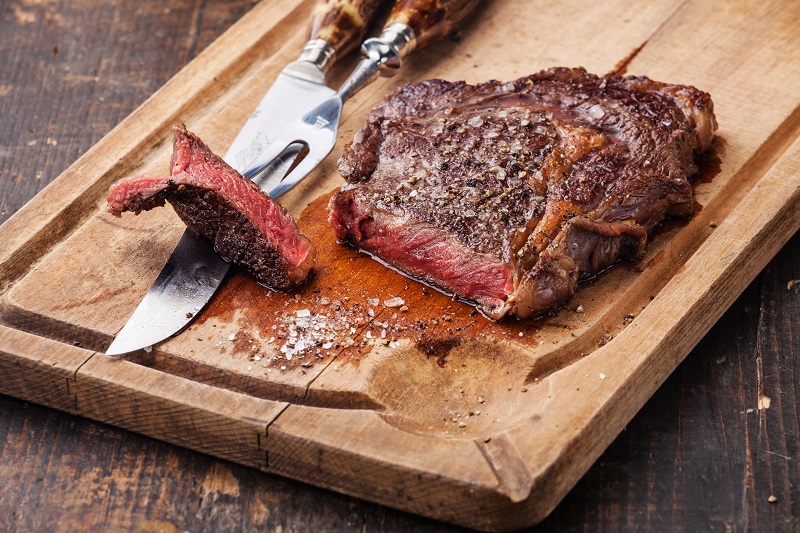
People are always asking me how to grill a ribeye. Americans pride themselves on being steak eaters, so we ought to be experts, right? Sadly, I think folks ruin more steaks than they grill right. Here are some easy hints:
Buy a thermometer. We get quick read digital thermometers for $10.00. One with all the bells and whistles might go for $40.00. I’ve seen them as high as $120.00, but the fancy ones still don’t cook the steak for you. Thermometers eliminate all the subjective steak tests like feel. Ever seen the feel test that compares the pressure-response of the chin to well-done steak, nose to medium and cheek to rare? It can work, but I know people with fat chins. And I’ve seen NY strips that are firm at rare. Subjective. Go with the technological absolute—digital thermometer.
Make sure the steaks are ready. That means thawed. Completely. Our beef is flash frozen and vacuum packed, so we just drop a steak in a bowl of tap water for about an hour to thaw it. You can also thaw it overnight in your refrigerator.
Get the grill hot. Use this time to clean it from last weeks salmon if you haven’t already (ever have a fishy ribeye? ugh.) I use a brass brush and a spatula to scrape. There’s nothing like a good grill-on-high preheat to get rid of off flavor. If using a charcoal grill, I always use a volcano type coal igniter. Lighter fluid can really ruin the flavor of steaks and make them taste like a South Texas oil refinery. And don’t use those ‘match-light briquettes’. They have tons of lighter fluid built right in. I like to sprinkle a little green apple wood or soaked mesquite on the coals or gas grill fire plate before I put that beef on.
Get that grill turned down to medium heat about 3 minutes before throwing the steaks on. With charcoal, your coals are white and hot—so raise your grate a little since you can’t turn them down. While waiting, get some water in a squirt bottle. I just use a plastic water bottle with a squirt lid on it. You’ll need this to quench any grill fires you may have.
What about seasoning? For a ribeye or NY strip, I don’t bother. These steaks should have enough flavor to go without. We use a little salt and pepper at the table, but nothing else.
Put those steaks on! I shape the steaks how I want them as I place them on the grill—you don’t want to stretch a cut out on the hot grill—it will stick fairly quickly and warp as it shrinks. I arrange them so all steaks are exposed to the same amount of heat, provided that they are the same thickness. If grilling different thicknesses, arrange them accordingly or put them on at different times.
The steaks should fairly sizzle when they hit the grate. If they don’t, your grill is too cold. If they hit the grate and cause a firestorm, maybe you have a little too much inferno on your hands. Shut the lid and start being patiently watchful. This is a good time to get that thermometer ready for a test probe and get that drink you may need to keep cool while grilling.
Flare ups can happen quickly, especially if you are grilling a well finished and marbled steak. Always be on the alert with your squirt bottle. Just a quick shot at the base is all it takes. Use care on charcoal-you don’t want to lose your coal bed with too much water.
Lets take a look. Insert the thermometer probe into the middle of the side (not the top) of the thinnest steak—that is your canary in the coal mine. When it reads in the 80’s in the middle of the meat, it is time to turn. Use tongs or a spatula—never a fork (don’t want to break that seared seal and drip precious juices). Flip quickly and decisively. My friend Greg always impresses me when he grills a steak or makes a cup of coffee. He moves very quickly and decisively, never second guessing his movements. It all looks very impressive—like he might even know what he is doing. Your guests will be impressed as well, provided you don’t flip a steak right on to the lawn…or into Fido’s hopefully waiting (and equally impressed) mouth.
Maybe you are wondering what happens to that thermometer on the flip. We use a heat proof resident type with the cable. It can just live right there in the grill. The key is on the insert point. Insert from the side so you can flip.
OK, back to the grill. Shut that lid whenever you can to increase smoke (remember that applewood/mesquite?) and reduce oxygen that can generate yellow fat fires. When your temp now reads 95 degrees F or so, turn again. I rotate the steaks 90 degrees as I flip them so that my grill marks make an ‘X’. That way I know I did two turns.
Here is where I might digress a little about thin steaks (Anything under 1 1/4 inches is thin). These I turn once. First turn around 95 degrees F. Second, off at 138 degrees F. See the next paragraph for temps for different tastes.
Back to thick steaks. Do not forget to control fires (seems like guys are all about this as most of us wanted to be fireman when we grew up). Another turn and rotation at 105 degrees F. The final at 136-138 degrees F. That is medium rare. Figure 138-143 degrees F for medium, and 144+ degrees F for well done. Be aware that if your steaks are lean, you probably do not want to go into medium territory. Without any fat, you are now making jerky if you go to medium. Moisture is a major part of the ‘mouthfeel’ (one of those intense culinary terms) in steak enjoyment.
Now, please pay attention to this important step during takeoff. I have a glass or ceramic plate waiting (not below room temp, but not heated either) to receive the finished steaks and a stainless steel bowl to put over them. You want to keep them covered to hold in the heat for about 5 minutes to finish cooking the steak. If you cut into it right now, immediately off the grill, you will have a totally gut rare strip in the middle of the cut (although some of you I have met love that). But if you cover them and wait thermal inertia steps in and finishes cooking the steak. Interior temp still rises even when off the grill, for the same reason that July and August days are the hottest, even though the longest day (and the most sun exposure) of the year, June 21st is long past.
So give it five minutes before cutting. This is the time to salt (we use sea salt—regular salt tastes bleachy) and pepper the cuts. Call the guests, pour that Cab Sav, and enjoy.
And remember—like with everything, practice makes perfect!!

 Braised Beef Short Ribs Recipe For a Busy Day
Braised Beef Short Ribs Recipe For a Busy Day
Leave a Reply